

Flexible Seating and Student-Centered Classroom Redesign. I remember exactly where I was when I had a watershed moment that changed me as a teacher forever.
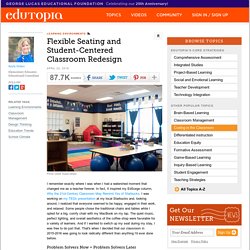
In fact, it inspired my EdSurge column, Why the 21st-Century Classroom May Remind You of Starbucks. I was working on my TEDx presentation at my local Starbucks and, looking around, I realized that everyone seemed to be happy, engaged in their work, and relaxed. Some people chose the traditional chairs and tables while I opted for a big, comfy chair with my MacBook on my lap. The quiet music, perfect lighting, and overall aesthetics of the coffee shop were favorable for a variety of learners. And if I wanted to switch up my seat during my stay, I was free to do just that. Problem Solvers Now = Problem Solvers Later I'm a firm believer in keeping the focus on what's really important: the students.
What the Research Says. 5 Quick Classroom-Management Tips for Novice Teachers. I made a good number of blunders my first year teaching that still make me cringe.
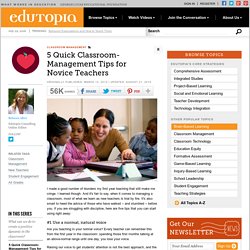
I learned though. And it's fair to say, when it comes to managing a classroom, most of what we learn as new teachers is trial by fire. It's also smart to heed the advice of those who have walked -- and stumbled -- before you. If you are struggling with discipline, here are five tips that you can start using right away: Classroom Management Basics. "The most important action an effective teacher takes at the beginning of the year is creating a climate for learning.
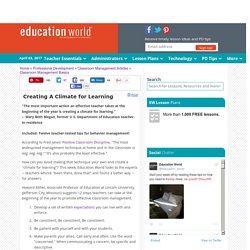
" -- Mary Beth Blegan, former U.S. Department of Education teacher-in-residenceIncluded: Twelve teacher-tested tips for behavior management! According to Fred Jones' Positive Classroom Discipline, "The most widespread management technique at home and in the classroom is nag, nag, nag. " "It's also probably the least effective. " How can you avoid making that technique your own and create a "climate for learning"? This week, Education World looks to the experts -- teachers who've "been there, done that" and found a better way -- for answers. Howard Miller, Associate Professor of Education at Lincoln University (Jefferson City, Missouri) suggests 12 steps teachers can take at the beginning of the year to promote effective classroom management. Three Types of Logical Consequences. Teachers who use the Responsive Classroom approach learn a variety of strategies for responding to misbehavior; logical consequences are one of those strategies.
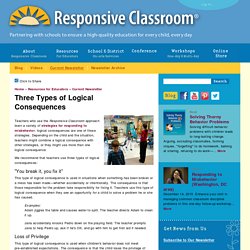
Depending on the child and the situation, teachers might combine a logical consequence with other strategies, or they might use more than one logical consequence. We recommend that teachers use three types of logical consequences: "You break it, you fix it" This type of logical consequence is used in situations when something has been broken or a mess has been made—whether accidentally or intentionally. The consequence is that those responsible for the problem take responsibility for fixing it. Examples: Adam jiggles the table and causes water to spill.
Jana accidentally knocks Pedro down on the playing field. Do Seating Arrangements and Assignments = Classroom Management? Now might be a good time to take a long look at your classroom seating arrangement.
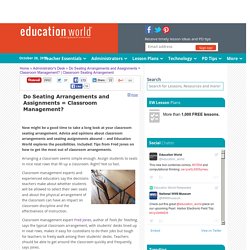
Wire Side Chat: Harry K. Wong and Classroom Management. Meet Harry K.
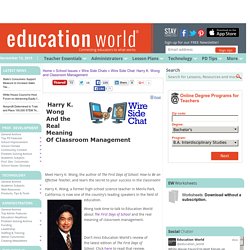
Wong, the author of The First Days of School: How to Be an Effective Teacher, and learn the secret to your success in the classroom! Harry K. Wong, a former high-school science teacher in Menlo Park, California, is now one of the country's leading speakers in the field of education.
Five Great 'Teacher Tips' Sites on the Web. Education World introduces you to a few of the best "teacher tips" sites on the Web.
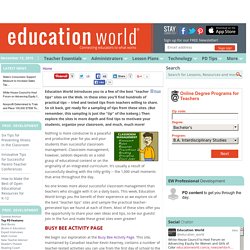
In these sites you'll find hundreds of practical tips -- tried and tested tips from teachers willing to share. So sit back, get ready for a sampling of tips from these sites. (But remember, this sampling is just the "tip" of the iceberg.) Teachers, Start Your Engines: Management Tips from the Pit Crew. Top 5 Classroom Management Strategies.
Strategies for Good Classroom Management My biceps don’t bulge and my hair is blond.

Intimidation is not my weapon. I am a veteran teacher with 17 years of experience. I have taught senior auto mechanics Shakespeare. In addition to high school students, I have taught middle school students who have had ADHD, students who had parents in jail and students with their own parole officers. In the real world, students come from all walks of life. Time-Out & Teaching Self-Regulation. As a classroom teacher I looked forward every year to teaching students all kinds of academic concepts and skills that would enable them to be engaged and successful in their learning.
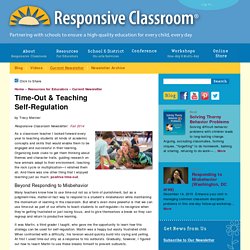
Organizing book clubs to get them thinking about themes and character traits, guiding research on how animals adapt to their environment, teaching the rock cycle or multiplication—I relished them all. And there was one other thing that I enjoyed teaching just as much: positive time-out. Beyond Responding to Misbehavior Many teachers know how to use time-out not as a form of punishment, but as a judgment-free, matter-of-fact way to respond to a student’s misbehavior while maintaining the momentum of learning in the classroom. Public Discipline Systems. Public discipline systems—like Class Dojo, stoplights, moving clothespins along a colored card, writing names on the board—can certainly be appealing.
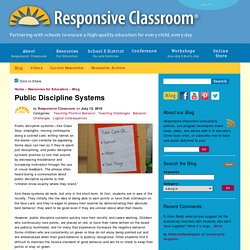
Some days can feel as if they’re spent just disciplining, and public discipline systems promise to turn that around by decreasing misbehavior and increasing motivation through the use of visual feedback. The phrase often heard during a conversation about public discipline systems is that “children know exactly where they stand.” And these systems do work, but only in the short-term. At first, students are in awe of the novelty. They initially like the idea of being able to earn points or have their clothespin on the blue card, and they’re eager to please their teacher by demonstrating their absolute best behavior; they want to be good even if they are unclear about what that means. Classroom Management Strategies for Difficult Students. Teachers in middle level schools face overwhelming demands and challenges in their classrooms. They are expected to know content and pedagogy, develop engaging lessons that meet the needs of diverse learners, and use a variety of instructional strategies that will boost student achievement while they simultaneously develop positive relationships with, on average, 125 students each day who are experiencing the personal, social, and cognitive challenges and opportunities of early adolescence (Carnegie Council on Adolescent Development, 1995; Schmakel, 2008).